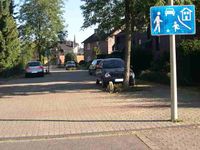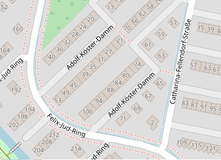Tag:highway=living_street
| Description |
|---|
| Road with very low speed limits and other pedestrian friendly traffic rules. |
| Rendering in OSM Carto |

|
| Group: highways |
| Used on these elements |
| Implies |
| Useful combination |
| Status: approved |
| Tools for this tag |
|
The highway=living_street tag is used to tag ![]() living streets or other implementations of shared space. These types of roads have lower speed limits and special traffic and parking rules compared to residential streets.
living streets or other implementations of shared space. These types of roads have lower speed limits and special traffic and parking rules compared to residential streets.
A general feature of living streets is that the legislation grants pedestrians higher or equal right of way over other road users. The implicit speed limits set in legislation vary from "walking speed" up to 20 km/h. In some countries, the speed limit is given explicitly on a sign.
Terms for these street vary considerably around the world and include Home Zone (UK), Erf/Woonerf (Netherlands/Flanders), Verkehrsberuhigter Bereich (Germany), Begegnungszone (Switzerland), Zone de rencontre (France). See the table below for details on the names and the legislations.
How to map
Create a simple way and tag it with highway=living_street and with name=* and traffic_sign=* when applicable. The maxspeed=* tag can be added regardless of whether the traffic sign leads to an implicit speed limit according to the legislation of the country.
For example: in countries where the traffic sign for a living street lead to an implicit speed limit, maxspeed=* is still tagged in more than 99% of the road length nevertheless. Keep in mind that (as of November 2023), there are no data users known that have a comprehensive catalogue of speed limit legislation, especially considering that in many countries this is legislated by local jurisdictions rather than country-wide. Correlation between OSM values for highway=* and actual traffic signs is seldom perfect.
If a street is subject to living-street traffic rules but highway=living_street is inapplicable, e.g. because a different highway=* value such as service is better, you can instead add living_street=yes.
Rendering
National specialities
| Country | Name | Traffic sign | maxspeed= | Special traffic rules | Reference |
|---|---|---|---|---|---|
| Australia | 10 (can vary) | Give way to pedestrians. A thoroughfare with low speed limits (often 10-20 km/h) where pedestrian traffic is given higher priority over vehicles. | Australian Tagging Guidelines/Roads | ||
| Austria |
Wohnstraße |

|
Schrittgeschwindigkeit[1] |
Give way to pedestrians and bicyclists; no transit traffic except for bicycles; exceptions e.g. for fire brigade or waste disposal; parking only in marked spaces; if exiting the "Wohnstraße" you have to give way (yield sign not present); it is always legal to cycle against the oneway direction | DE:Tag:highway=living street#Wohnstraßen, |
| Begegnungszone | 
|
höchstens 20[2] | Transit traffic allowed. People can stay, walk, and play on the road. | DE:Tag:highway=living street#Begegnungszonen, | |
| Belarus | Жилая зона (Zhilaya zona) | 20[3] | Give way to pedestrians and bicyclists. No transit traffic. Way has a name. Use highway=service living_street=yesfor unnamed ways.
Жилая зона − улица имеющая название, въезды на которую и выезды с которой обозначены дорожными знаками ”Жилая зона“ и ”Конец жилой зоны“, исключая дворовую территорию.[4] |
Правила дорожного движения Республики Беларусь | |
| Belgium |
Woonerf |
20 | Drivers must give way to pedestrians; pedestrians can use the entire road; special rules for parking a car. | ||
| Bosnia and Herzegovina | Zona smirenog saobraćaja | Walking speed | |||
| Bulgaria | 'Жилищна зона' (Zhilishtna zona) | 20 | Drivers must give way to pedestrians. Pedestrians can use the entire road. Pedestrians should not unreasonably hinder motor traffic. Parking allowed only on marked places. If exiting the "Zhilishtna zona" you have to give way. | ||
| Croatia | Područje smirenog prometa | 10 | |||
| Czech Republic | Obytná zóna |  |
20 | Drivers must give way to pedestrians. Pedestrians can use the entire road, including for play. Pedestrians should not unreasonably hinder motor traffic. Parking allowed only on marked places. | |
| Denmark |
'Opholds- og legeområde' |
default 15, at most 30 | Pedestrians may use the entire road; drivers must give way to pedestrians; parking only in marked spaces. | Bekendtgørelse om Vejafmærkning | |
| Estonia | Õueala | 20 (or walking speed if pedestrians are nearby) | Give way to pedestrians. The engine must be turned off after two minutes of parking. Pedestrians should not unreasonably hinder motor traffic. Pedestrians can use the entire road. No transit traffic. | ||
| Finland | Pihakatu | 20 | Favours pedestrians, cars must give way. Parking allowed only on marked places. Speed "adapted to pedestrians and not exceed 20". | ||
| France |
'Zone de rencontre' |
20 | Drivers must give way to pedestrians; pedestrians can use the entire road. Introduced in 2008. | ||
| Germany | Verkehrsberuhigter Bereich (colloquially, Spielstraße) |  |
Walking speed | Give way to pedestrians. Parking only allowed in marked places. On exiting the road drivers have to give way (yield sign not present). | |
| Hungary | Lakó-pihenő övezet |  |
20 | Give way to pedestrians. Parking only allowed in marked places; no transit traffic except bicycles. | Hungarian highway code (KRESZ) |
| Iceland | Vistgata | 15 (or walking speed if pedestrians are nearby) | Give way to pedestrians. Parking only allowed in marked spaces, except for bicycles. Pedestrians should not unreasonably hinder motor traffic. | ||
| Ireland | N/A | N/A | No special legal category corresponding to Living Streets exists in Ireland. Tag as residential with maxspeed of either 50 or 30 as indicated by signs. | ||
| Italy | Zona residenziale | N/A | Living streets do not exist in Italy. The sign |
Codice della strada art. 3 comma 58 | |
| Japan | N/A | N/A | No special legal category corresponding to Living Streets exists in Japan. Tag as residential with maxspeed as indicated by signs (usually 30 or 20). | ||
| Jersey | Green Lane | 15 mph | Designated as priority for pedestrians, cyclists and horse riders. | ||
| Latvia | Dzīvojamā zona | 20 | Give way to pedestrians and bicycles, who may move freely, but not unnecessarily hinder traffic. Parking only allowed in marked places, or, if none present, in places that don't hinder traffic. No trucks >5 t or buses >6 m. Upon exiting the zone, give way to everyone. | Ceļu satiksmes noteikumi 13. | |
| Netherlands | Erf |  |
15 | Identified by traffic sign NL:G5. Pedestrians can use the entire road, parking only in designated spaces. Not necessarily a residential area. Zonal by nature (living street doest not end when sign is not repeated after crossing) | |
| Norway | Gatetun | 8 | Vehicles must give way to all pedestrians. Walking speed for all vehicles. No parking exept in designated places. Trafikkreglene § 7.4. Kjørende som kommer fra [...] gatetun [...] har vikeplikt for annen trafikant. §9.2. Kjørende [...] har vikeplikt for gående [...] [i] gågate eller gatetun. §13. 3. På gågate eller gatetun må det ikke kjøres fortere enn i gangfart. §17. 2. Det er forbudt å parkere [...] d) på gatetun utenom særskilt anviste plasser. |
||
| Mexico | Calle residencial |  |
10/15/20 (can vary) | Doesn't exist on federal law, is used adapted Non Regulated by law |
|
| Poland | Strefa zamieszkania | 20 | Pedestrians (including playing children, even without parental supervision) can use entire street and have absolute precedence over vehicles. Parking is only allowed in marked places. Speed calming devices don't have to be marked using road signs. Also give way when leaving the zone[5] | ||
| Romania | Zonă rezidențială | 20 | Pedestrians (including playing children) can use entire street and have absolute precedence over vehicles. Parking is only allowed in marked places. | Reguli pentru circulaţia vehiculelor - Zona rezidenţială şi pietonală - Art. 158. | |
| Russia | Жилая зона (Zhilaya zona) | 20[6] | Give way to pedestrians. No transit traffic. Пешеходы имеют преимущество. Транзитный проезд запрещен. Жилая зона − территория, въезды на которую и выезды с которой обозначены дорожными знаками ”Жилая зона“ и ”Конец жилой зоны“[7]. Правила движения в жилых зонах распространяются также и на дворовые территории[8]. |
Правила дорожного движения Российской Федерации | |
| Serbia | Zona usporenog saobraćaja | 10 | Identified by traffic sign Pedestrians (including playing children, even without parental supervision) can use entire street and have absolute precedence over vehicles. Parking is only allowed in marked places. || | ||
| Slovakia | Obytná zóna | 20 | Pedestrians (including playing children, even without parental supervision) can use entire street and have absolute precedence over vehicles. Parking is only allowed in marked places. | ||
| Spain | Calle residencial | 20 |
Indica las zonas de circulación especialmente acondicionadas que están destinadas en primer lugar a los peatones y en las que se aplican las normas especiales de circulación siguientes: los conductores deben conceder prioridad a los peatones. Los vehículos no pueden estacionarse más que en los lugares designados por señales o por marcas. Los peatones pueden utilizar toda la zona de circulación. Los juegos y los deportes están autorizados en ella. Los peatones no deben estorbar inútilmente a los conductores de vehículos. |
||
| Sweden |
Gårdsgata |
Walking speed (10?) | Favours pedestrians, cars must give way. Parking allowed only on marked places. When exiting a "Gångfartsområde" you have to give way (yield sign normally not present) | ||
| Switzerland | Begegnungszone |  |
20 | Appears in residential or commercial areas. Pedestrians may use the entire road. All vehicles, including bicycles, must give way to pedestrians. Pedestrians must not unnecessarily hinder traffic.
Parking for motor vehicles only in designated spaces (markings or signs) |
|
| Turkey | Yaya öncelikli yol | 20 | Identified by traffic sign Give way to pedestrians. Parking only allowed in marked spaces, except for bicycles. Pedestrians should not unreasonably hinder motor traffic. Cars should yield while exiting. | ||
| United Kingdom | Home Zone | 20 mph
The minimum legal speed limit is 20 mph on public highways however Living Streets have a design aim of 10-15 mph through the use of traffic calming |
Highway Code point 218 | ||
| United States | There are no national standards; traffic regulations vary by region. Some urban areas have road designations that meet the living street criteria. See Tag:highway=living_street#United States below. |
Remarks
Germany
The colloquial word Spielstraße is commonly used for the legal term Verkehrsberuhigter Bereich. But in administrative regulations (VwV-StVO) the legal word Spielstraße is used for a rare combination of an exclusion of all vehicles combined with an additional sign for playing children.
No numeric speed value is set by law for Schrittgeschwindigkeit (walking pace speed). A Tempo 30-Zone is not a living street. maxspeed=walk can be assumed and doesn't need to be set individually.
In Germany, a verkehrsberuhigter Bereich is a zone with signs indicating start and end of the affected area. For this reason, parking areas, pedestrian walkways, or other features could be considered part of such a zone. The tag highway=living_street should only be used for road-like sections intended for driving cars and other motor vehicles. Paths intended for pedestrians and/or cyclists should always be tagged with highway=path or highway=footway, even if they could technically/legally be considered also part of such a zone.
Canada
There exists a living street in Banff where pedestrians have right-of-way, but living streets are exceptionally rare in Canada. Sometimes small residential roads are incorrectly tagged as living streets.
United States
New York City has roads tagged as highway=living_street where pedestrians and cyclists have right-of-way and only low-speed local traffic is permitted.
The City of Seattle has established several "Healthy Streets" where through traffic is forbidden, and pedestrians and cyclists share the carriageway with local traffic. See the Seattle Department of Transportation website. Tagging these as highway=living_street has been controversial because pedestrian-safe speed limits are not part of the initiative. See the talk page for discussion.
Mappers in some parts of the USA sometimes use this tag for roads with a low speed limit and a turning circle at the end. However, if these lack explicit signage and legal designation that qualifies them as living streets, they are better tagged using access tagging and the actual maxspeed=* instead.
Support
Routing and navigation software might try to avoid such areas when navigating cars.
Possible tagging mistakes
See also
- highway=residential
- highway=pedestrian
- Proposal living_street=yes
- Guidelines for pedestrian navigation
References
- ↑ StVO § 76b
- ↑ StVO § 76c
- ↑ ПДД РБ. Глава 11. Пункт 88
- ↑ RU:Belarus:Примеры обозначения дорог внутри населённых пунктов
- ↑ “Internetowy System Aktów Prawnych” (in Polish). Dz. U. 1997 nr 98 poz. 602 (with further changes - the unified text). 2012. Retrieved 2013-03-12.
- ↑ ПДД РФ. Пункт 10.2
- ↑ ПДД РФ. Пункт 17.1
- ↑ ПДД РФ. Пункт 17.4
| ||||||||||||||||||||||||||||||


